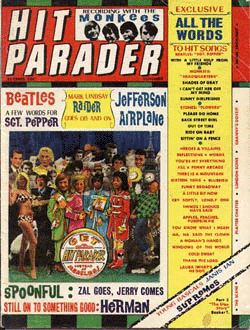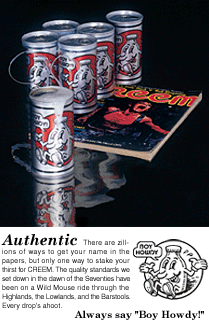Headlines | LoudMouth | Shows & Events | Hall of Fame | Interviews | Reviews | Multimedia | Klassifieds | Back Issues | Links | Myspace

Headlines | LoudMouth | Shows & Events | Hall of Fame | Interviews | Reviews | Multimedia | Klassifieds | Back Issues | Links | Myspace

COLUMNS
THE GREAT ROCK & ROLL MAGAZINE DEBATE by John "Stoney" Cannon
With those words Jann Wenner introduced the first issue of Rolling Stone. The year was 1967 and the place? San Fransisco, California smack in the middle of the Haight-Ashbury era.
With the Vietnam War in mid swing and the country’s youth attempting to follow the Beatles move from clean cut pop stars to the cutting edge of teen independence, it was only fitting that this first issue feature a militarily clad John Lennon on the cover. Granted it was merely a still from a movie, the impression at the time was striking and would prove to be an odd beginning of a period that took Lennon from being music's spokesperson for peace and the anti-war movement to being brutally murdered nearly a dozen years later. All of a sudden rock & roll and youth culture had its own survival guide. Or did it?
In March of 1969 Publisher Barry Kramer unleashed CREEM upon the unsuspecting patrons of the Detroit arts and music community. While the world has been privy to the city's soul and blues homespun sounds, Kramer chose to light a fire that he labeled "A rock n roll magazine for the people." Following a time of rioting in and around the city, CREEM was to cover the growing underground rock and roll scene as well. While much of the music amounted to little elsewhere, in Detroit it was (and remains) a lifestyle. From the blue collar personality of the Motor City (and eventually world's murder capital) working mans (and women’s) rock and roll slowly crept into the national subconscious before exploding with politically charged bands such as the MC5 as well as rockers looking to bring a little life into the lovey dovey musical musings of the final grasps of the summer of love. Artists such as the Stooges, Alice Cooper and eventually pro-gun, anti-animal rights, anti-vegetarian, hell just about anti-everything, motor city madman himself Ted Nugent would emerge to put the nation on its ravaged ear and wake up a nation of smoke brained rockers and welcome them to the party. Detroit was so important a music city in its day that KISS played tribute on the opening minutes of their 1976 classic Destroyer via the song "Detroit Rock City". Without CREEM leading the way one has to imagine if these sonic sounds would have reached a nation in dire need of yet another wake up call. The importance of CREEM and sixties counterpart Rolling Stone were proved even more evident at this years Rock & Roll Hall of Fame through the induction of Wenner as a non-performer and the Motor City’s own son Bob Seger, a performer introduced to the national music mainstream by way of CREEM. Over thirty years later and the impact is still being felt. But now we’re getting way ahead of ourselves.
At a time when rock and roll was still finding its feet, young fans everywhere grew side by side with their rock and roll heroes, rock magazines as their bibles. A kid’s first rock concert was a rite of passage and in many rural areas teens witnessed this world through the words and photos on the pages of whatever rock read they could get their hands on. Upcoming label bands would change this for a short time in the early seventies by traveling to small town were no rock bands had dared to go before. Imagine a major band these days visiting small towns in the Midwest.
By the mid seventies newer mags like CIRCUS had come along to help ring in the “Arena Rock” era and introduce rock and roll to a whole new generation of fans hungry for the new faces that would represent their right to rebel for independence. Rock’s early stars were now legends and many of the new rockers were considered gods that would lead the way to rock and roll salvation. Sex, Drugs and Rock & Roll were not just a cool saying, but a way of life that every kid sought to accomplish despite the awkwardness of the trials and tribulations of being a teenager. With the quality and color improving year by year, it would be easy to see the impact these magazines made during a time when glam, glitter and punk were king. Imagine trying to explain the likes of Bowie, KISS, the Sweet, and Sex Pistols to a fresh faced rock virgin without the great photos these periodicals provided. Records, while large in size, usually only offered a visual glimpse of what an artist looked like and rarely featured quality live pictures. Today one just has to pop a cd in their computer for more info or check out a bands website, but thirty years ago fans only had record sleeves, concerts and magazines. But maybe, just maybe, the limited access that the era’s followers had to their favorite artists was a large reason for the magic and the larger than life personas seemingly lived by the rock stars of the day.
As the decade came to a close, a rock and roll that once was embodied by many styles of music had begun to splinter into various genres and rock magazines leaned toward the style best suited for its writers. Rolling Stone continued to cover all things classic and political while CREEM hit the eighties chock full of punk and new wave bravado, at times filling articles with ramblings that left the reader asking “was that a joke or what?”. CIRCUS rode arena rock into the metal age along with new rags like Metal Edge, Faces and more. Matter of fact, the decade welcomed no less than fifty major market “metal mags” most of which offered no more than a mere whimper on the rock and roll magazine map.
While the importance of visuals was evident on the seventies, the eighties possibly represented the most colorful and diverse decade in rock and roll history and Rolling Stone and its contemporaries played a huge part in bringing all the color to the world. Where rock fans once looked to their fave magazines for info on the newest bands, now they sought to use these pages of info to learn more about the visions flashing across their tv screens. MTV ushered in a new style of promotion and hype and while it took some of the reasons for buying a rock read away, it gave fans a whole new reason to buy and collect issues, some directly dedicated to their favorite stars. Sex, Drugs and Rock & Roll were traded in for a new motto of “Aids, Crack and Madonna” and the anti-war politics of the day replaced by artists speaking out on human rights, the evils of drug use and of course, world hunger. With the shooting of John Lennon it almost seemed as if rock and roll changed its face overnight. Activism among rockers was at an all time high and while Rolling Stone brought us all the politically correct details, it along with other magazines showed us that rock and roll was still about excess. For every U2 out to send a message there was a Motley Crue there to remind us that you only live once.
But just as soon as the rock world looked like it was about to explode due to an overload of color, a dark cloud enveloped rock and roll and all of a sudden it was hard to tell the major stars from their fans. Bruce Springsteen had always been the workingman’s champion and in a mere flash a whole slew of contenders arrived from the Northwest to champion the downtrodden youth sick of hearing the “nuthin but a good time” message of the previous decade. Almost overnight Rolling Stone rediscovered the honesty of black and white photography and magazines such as Spin showed up to offer up a more “alternative spin” on modern music. Aids, while still an issue, fell to the wayside of other worldly topics, heroine made a comeback and genres like grunge and nu metal were a direct result.
Today, good or bad, politics still play a part in rock and roll just as much as partying and catchy choruses. Rolling Stone still delivers the skinny on rock and roll but in 2003/04 has replaced their always classic rock covers with images of teen idols and stars. CREEM returned after a lengthy absence and the rock world is now ruled by the likes of more independent magazines such as Spin, No Depression, Ice and more.
The days of rock stars may have given way to a future of artists and musicians, but no matter what the circumstance, fans will always be able to find out info on their favorite bands or discover new talent within the pages of the rock magazine of their choice.
John "Stoney" Cannon
"You're probably wondering what we're trying to do. It's hard to say - sort of a magazine and sort of a newspaper. The name of it is Rolling Stone."




If truth be told, Hit Parader Magazine had been covering the music of the day close to 20 years before Rolling Stone first appeared. Originally beginning as a top 10 lists magazine that featured mainly teen idols and "safe" artists of the period, by the mid sixties Hit Parader 's cover features were filled with articles about such rockers as the Beatles, Rolling Stones, and a ton of the bands from the original British Invasion. But through the evolving changes in musical styles, Hit Parader remained a reader for those wanting to know the intimate details of their favorite musicians while Rolling Stones' writers sought out to examine not only the fervor of rock & roll but also the generational and political conscience of our country and the effect it played out on those of the Woodstock Generation and forward. What started out as "sort of a magazine and sort of a newspaper" in the Bay area eventually spawned into a national guide that bridged the gap between the musical freedom normally sought after by the country's youth and political knowledge which up to then had been reserved for after hours cocktail discussion of the over thirty crowd. But while its attempts at raising awareness of each side to the other continued, Rolling Stone also pushed the envelope even further refusing to offer its information solely to the mainly white male dominated culture of the era. The equality of women and minorities would find allies in such covered artists as Janis Joplin, Sly Stone, James Brown, Carol King and others over the publications first decade. But where Rolling Stone was to fire up the imaginations of a rock & roll generations, other publications continued the fight for freedom of expression and literary change. One such magazine was CREEM.